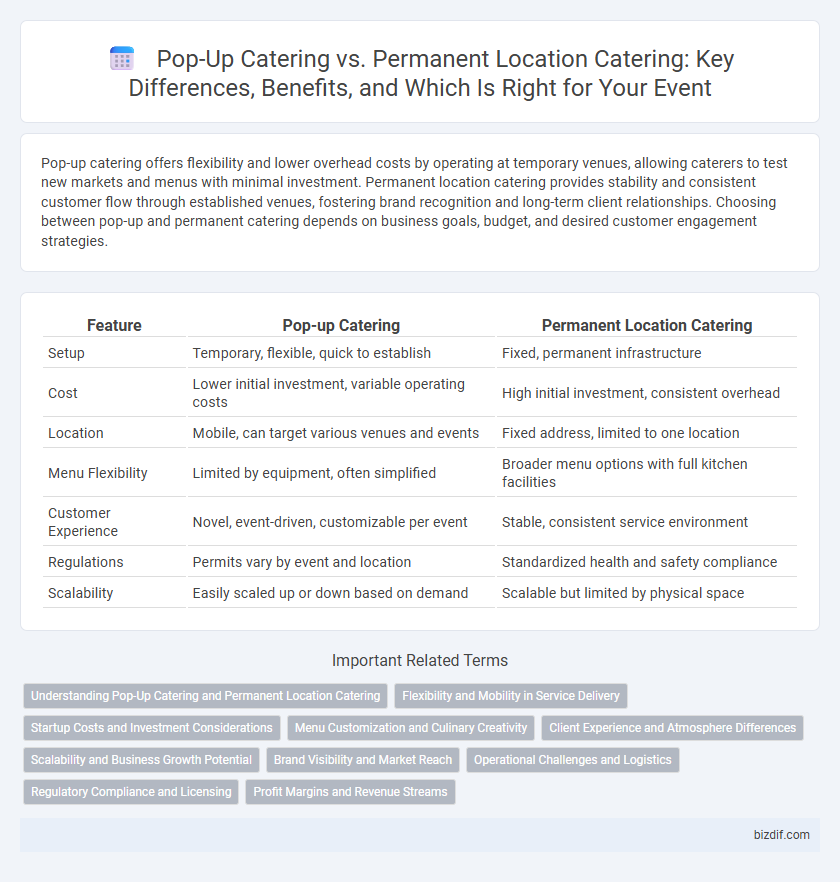Pop-up catering offers flexibility and lower overhead costs by operating at temporary venues, allowing caterers to test new markets and menus with minimal investment. Permanent location catering provides stability and consistent customer flow through established venues, fostering brand recognition and long-term client relationships. Choosing between pop-up and permanent catering depends on business goals, budget, and desired customer engagement strategies.
Table of Comparison
| Feature | Pop-up Catering | Permanent Location Catering |
|---|---|---|
| Setup | Temporary, flexible, quick to establish | Fixed, permanent infrastructure |
| Cost | Lower initial investment, variable operating costs | High initial investment, consistent overhead |
| Location | Mobile, can target various venues and events | Fixed address, limited to one location |
| Menu Flexibility | Limited by equipment, often simplified | Broader menu options with full kitchen facilities |
| Customer Experience | Novel, event-driven, customizable per event | Stable, consistent service environment |
| Regulations | Permits vary by event and location | Standardized health and safety compliance |
| Scalability | Easily scaled up or down based on demand | Scalable but limited by physical space |
Understanding Pop-Up Catering and Permanent Location Catering
Pop-up catering involves temporary food service setups at various locations, offering flexibility and unique dining experiences for events or short-term engagements. Permanent location catering operates from a fixed venue, providing consistent service and a stable environment for regular customers or large-scale functions. Understanding these distinctions helps clients choose between the dynamic, event-focused nature of pop-up catering and the reliable, full-service offerings of permanent location catering.
Flexibility and Mobility in Service Delivery
Pop-up catering offers unparalleled flexibility and mobility, enabling businesses to serve diverse locations and adapt quickly to event-specific requirements without the constraints of a fixed venue. Permanent location catering provides stability and consistency but lacks the adaptability to move and customize setups for varied environments. Leveraging pop-up catering enhances customer reach and responsiveness, critical for dynamic event-driven markets.
Startup Costs and Investment Considerations
Pop-up catering requires significantly lower startup costs compared to permanent location catering, as it eliminates expenses like long-term leases, extensive kitchen equipment, and full-time staff salaries. Investment considerations for pop-up catering primarily involve flexible, short-term permits, mobile equipment, and marketing to rapidly establish a customer base. Permanent locations demand higher upfront capital for space renovation, utilities, comprehensive kitchen installations, and consistent operational overhead, necessitating a more substantial financial commitment and strategic business planning.
Menu Customization and Culinary Creativity
Pop-up catering offers unparalleled menu customization and culinary creativity by allowing chefs to experiment with seasonal ingredients and unique concepts tailored to specific events. Permanent location catering typically features a fixed menu designed for consistency and operational efficiency, limiting the scope for spontaneous innovation. Event planners seeking dynamic and bespoke dining experiences often prefer pop-up catering for its flexibility and ability to deliver highly personalized menus.
Client Experience and Atmosphere Differences
Pop-up catering provides a dynamic and flexible client experience by offering unique, temporary dining events that enhance exclusivity and novelty. Permanent location catering delivers consistent atmosphere and reliable service, fostering a familiar environment that supports ongoing client relationships. The pop-up model excels in creating memorable, one-time events, while permanent venues ensure comfort and predictability for repeat customers.
Scalability and Business Growth Potential
Pop-up catering offers unparalleled scalability by allowing businesses to quickly test new markets and adapt menus without the overhead of a permanent location, facilitating rapid business growth. Permanent location catering provides stability and consistent customer engagement but may limit expansion due to higher operational costs and fixed capacity constraints. Businesses seeking agile growth often leverage pop-up catering to optimize resource allocation and capture diverse market segments before investing in permanent establishments.
Brand Visibility and Market Reach
Pop-up catering offers dynamic brand visibility by creating temporary, high-impact experiences that attract diverse customer segments and generate buzz in multiple locations. Permanent location catering builds consistent brand recognition through a stable presence, fostering loyal customer relationships within a specific market area. Combining pop-up events with a permanent catering venue maximizes market reach by leveraging both broad exposure and steady customer engagement.
Operational Challenges and Logistics
Pop-up catering presents unique operational challenges such as limited storage, temporary kitchen setups, and frequent transportation of equipment, complicating inventory management and food safety compliance. Permanent location catering benefits from established infrastructure, consistent supply chains, and dedicated staff, enabling streamlined operations and efficient workflows. However, pop-up services require agile logistics planning to adapt to varied venues and fluctuating demand, demanding flexible coordination and real-time problem-solving.
Regulatory Compliance and Licensing
Pop-up catering requires flexible adherence to local health regulations and often temporary food service licenses tailored for short-term operations. Permanent location catering demands comprehensive and ongoing compliance with building codes, food safety certifications, and business licenses specific to fixed establishments. Both models must navigate varying county and state mandates, but permanent locations typically face more stringent and continuous regulatory scrutiny.
Profit Margins and Revenue Streams
Pop-up catering often yields higher profit margins due to lower overhead costs and flexible location options, enabling caterers to capitalize on event-based demand and unique venues. Permanent location catering benefits from consistent revenue streams generated by repeat customers and established contracts, but higher fixed expenses such as rent and utilities can reduce overall profitability. Choosing between pop-up and permanent catering requires analyzing local market demand, cost structures, and potential for scalability to maximize financial performance.
Pop-up catering vs permanent location catering Infographic

 bizdif.com
bizdif.com